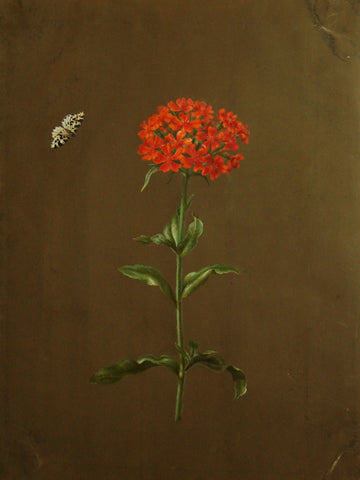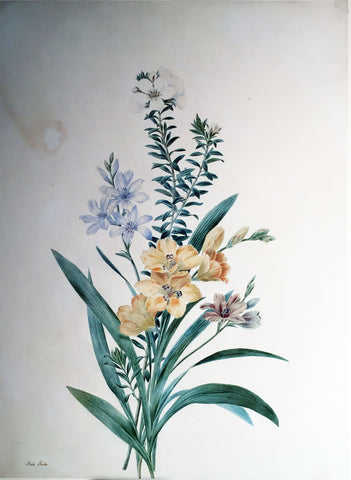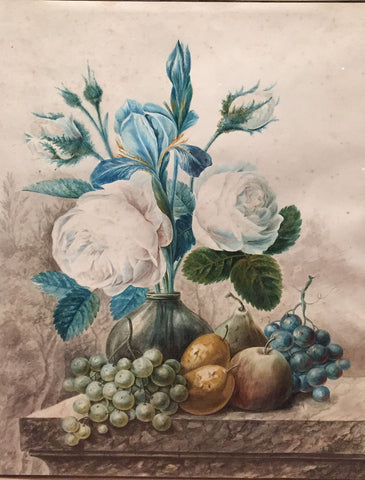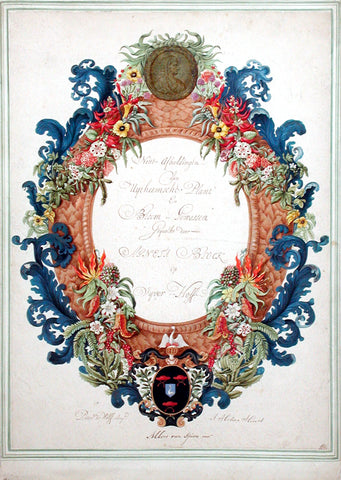
Barbara Regina Dietzsch (German, 1706-1783), Butterfly and Verbena
Barbara Regina Dietzsch (German, 1706-1783)
Butterfly and Verbena
Watercolor with gouache and gold leaf on vellum
ca. 1765
Vellum size: 14 x 10 3/4 in
Framed: 23 3/4 x 20 3/8 in
Provenance: Hans Müller, Düsseldorf, Germany
The verbena’s flowers are small with five petals and borne in dense spikes so that a brilliant bouquet of flowers appears to erupt from a tall, single stem. Dietzsch hones in on this dichotomy of abundance and simplicity, emphasizing the straightness of a single stem with clean, economical strokes to define the vertical axis of the composition, and softly painting the fluid undulations of its leaves and fragile rose-pink petals with gentle gradations in tone and color. The plant is valued in butterfly gardening in suitable climates, attracting Lepidoptera such as the Hummingbird hawk-moth, Chocolate albatross, or the Pipevine swallowtail, as well as hummingbirds; Dietzsch knowingly includes a black-spotted butterfly whose outstretched ivory wings are like a flash of light in the contrasting darkness. While scientifically accurate, the inclusion of this bright butterfly also picks up the subtle shades of white, creamy rose, and light grey brushed onto the petals and leaves, creating a sense of luminosity that animates the work throughout.
The gorgeous luminosity Dietzsch achieves here also speaks to the plant’s historical associations with divine and other supernatural forces. It was called “tears of Isis” in ancient Egypt, and was later referred to as “Hera’s tears.” In ancient Greece, it was dedicated to Eos Erigineia, a Titaness and the goddess of dawn, who rose each morning from her home at the edge of the Oceanus. In the early Christian era, folk legend stated that Vervena officinalis (common verbena) was used to staunch Jesus’ wounds after his removal from the cross, and it was consequently called “holy herb.”
Barbara Regina Dietzsch was a member of an important family of painters, engravers, and musicians that flourished in Nuremberg during the eighteenth-century. Dietzsch was particularly known for her marvelous renderings of flowers and fruit in watercolor and gouache. Employed at the court of Nuremberg, she drew extensively for engravers there, and her work was of such outstanding quality that it was used by Trew and Georg Ehret for a number of plates in the Hortus Nitidissimis (1750-86).
The patronage of Dr. Christoph Trew, the great botanist, and bibliographer, made Nuremberg one of the foremost centers of botanical art in the world, and the Dietzsch family was one of the most noted of the era. Even at the time of its production, the work of Barbara Regina Dietzsch was much sought after by collectors in both the Netherlands and in England. It is recorded that some of the best-known painters of the time accepted her works as a form of payment, signaling the great reputation she attained during her lifetime -- a celebration that has continued to grow in the intervening centuries.
Like most of her family’s work, Dietzsch’s watercolors are often characterized by the use of a black or dark brown ground and it is partly upon the basis of this that the current attribution has been based. This creates a dramatic contrast between the subject and background and emphasizes the sharp, hard finish of the drawing. The great flower painter Georg Ehret occasionally placed his bouquets on a dark background, but these are not nearly so successful as Dietzsch’s in making the subject come to life. Various examples of her work can be found in the Broughton Collection at the Fitzwilliam Museum, Cambridge, England and in each the dark ground is present.
What separates the work of Barbara Regina from that of her other family members is the remarkable clarity of depiction and skill in rendering. With unbelievable mastery and stylistic power, Dietzsch overcame contemporary estimations of women’s inferiority in the field of art, creating watercolors of distinctive splendor.
Please feel free to contact us with questions by phone at 215.735.8811,
or by email at loricohen@aradergalleries.
We Also Recommend





